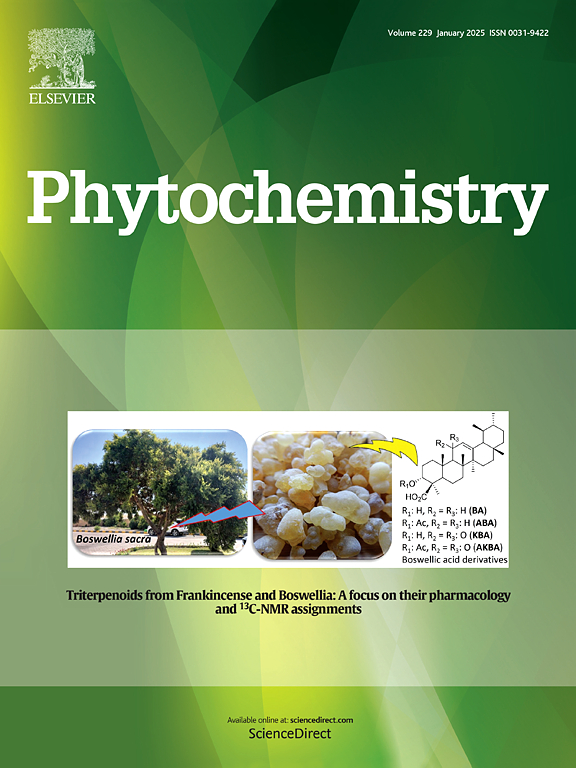大戟二萜和倍半萜及其神经保护活性
IF 3.4
2区 生物学
Q2 BIOCHEMISTRY & MOLECULAR BIOLOGY
引用次数: 0
摘要
大戟(Euphorbia helioscopia L.),在中国也被称为“泽七”,几十年来一直被用作治疗各种疾病的中药。在本研究中,对全株向日葵进行了植物化学研究,分离并鉴定了两个未被报道的lathyrane-type二萜,euphhelioscopids a(1)和B(2),以及一个未被报道的大芥子碱-type倍半萜类,euphhelioscopid C(3),以及20个已知的同源物(4 - 23)。基于广泛的光谱数据分析,ECD和STS策略计算的NMR,以及与先前报道的NMR数据的比较,阐明了它们的绝对构型结构。对分离的化合物对谷氨酸诱导的HT22细胞损伤的神经保护作用进行了评价。化合物1、3、5 ~ 8、13和17表现出不同程度的神经保护作用。值得注意的是,化合物1在5 μM的低浓度下表现出与阳性对照D/ l -3-正丁基酞(外消旋NBP)相当的活性,将细胞存活率从48.4%提高到82.6%。进一步的生物学评估,包括流式细胞术分析和凋亡相关蛋白Bcl-2和Bax的表达评估,显示化合物1通过抗凋亡途径减轻了谷氨酸诱导的神经元细胞死亡。这些发现表明,化合物1可能作为一种有价值的先导支架,用于开发新的神经保护剂。本文章由计算机程序翻译,如有差异,请以英文原文为准。

Diterpenoids and sesquiterpenoids from Euphorbia helioscopia and their neuroprotective activity
Euphorbia helioscopia L., also known as “Zeqi” in China, has been used for decades as a traditional Chinese medicine to treat various diseases. In this study, a phytochemical investigation of the whole plant of E. helioscopia resulted in the isolation and structural elucidation of two undescribed lathyrane-type diterpenoids, euphohelioscopids A (1) and B (2), and one unreported megastigmane-type sesquiterpenoid, euphohelioscopid C (3), along with 20 known congeners (4−23). Their structures with absolute configurations were elucidated, based on a combination of extensive spectroscopic data analyses, ECD, and calculated NMR with the STS strategy, as well as comparison with previously reported NMR data. The isolated compounds were evaluated for their neuroprotective activities against glutamate-induced damage in HT22 cells. Compounds 1, 3, 5−8, 13, and 17 exhibited varying degrees of neuroprotective effects. Notably, compound 1, at a low concentration of 5 μM, demonstrated potent activity comparable to that of the positive control, D/L-3-n-butylphthalide (racemic NBP), elevating the cell survival rate from 48.4 % to 82.6 %. Further biological evaluations, including flow cytometric analysis and assessments of the expression of apoptosis-related proteins Bcl-2 and Bax, revealed that compound 1 mitigated glutamate-induced neuronal cell death through an anti-apoptotic pathway. These findings suggested that compound 1 may serve as a valuable lead scaffold for the development of novel neuroprotective agents.
求助全文
通过发布文献求助,成功后即可免费获取论文全文。
去求助
来源期刊

Phytochemistry
生物-植物科学
CiteScore
6.40
自引率
7.90%
发文量
443
审稿时长
39 days
期刊介绍:
Phytochemistry is a leading international journal publishing studies of plant chemistry, biochemistry, molecular biology and genetics, structure and bioactivities of phytochemicals, including ''-omics'' and bioinformatics/computational biology approaches. Phytochemistry is a primary source for papers dealing with phytochemicals, especially reports concerning their biosynthesis, regulation, and biological properties both in planta and as bioactive principles. Articles are published online as soon as possible as Articles-in-Press and in 12 volumes per year. Occasional topic-focussed special issues are published composed of papers from invited authors.
 求助内容:
求助内容: 应助结果提醒方式:
应助结果提醒方式:


